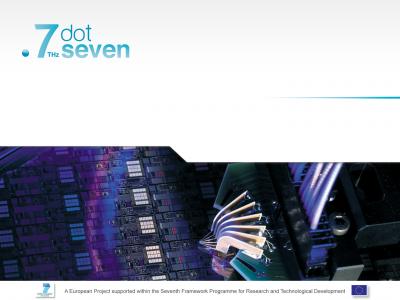Dotseven (DOT7)
Themes: XG - Next Generation Sensing and Communication
DOTSEVEN is a very ambitious 3.5 year R&D project targeting the development of silicon germanium (SiGe) heterojunction bipolar transistor (HBT) technologies with cut-off frequencies (fmax) up to 700 GHz.
The DOTSEVEN project is motivated by the increasing interest in utilizing the mm-wave frequency spectrum within the so-called THz gap (which ranges from 0.3 to 30 THz, cf. Fig. B1.1/1) for a wide variety of applications. Examples for these applications are >120GHz industrial sensors including mm-wave scanning and radar, extremely broadband ADCs with 50 to 100GS/s and >25GHz signal bandwidth at 5 to 6 bit resolution, 400Gb/s optical (backbone) transmission, as well as highly linear amplifiers, e.g., for 4G mobile communications. These circuits and systems serve a large variety of markets either delete refs or add refs to this information such as health care and biology (e.g., medical equipment, patient monitoring, tissue and genetic screening), infrastructure and construction (e.g., structural safety), mass transportation (e.g., security screening, automotive radar, in-seat entertainment), industrial automation (e.g., sensors), communications (e.g., high-bandwidth terrestrial point-to-point wireless, satellites). The deployment of the associated high-performance circuits and systems in commercial and military markets is driven mainly by cost, form-factor, and energy-efficiency. The rapidly increasing interest in THz-applications has most recently even spawned the start of a new IEEE Journal, namely the �Transactions on Terahertz Science and Technology�. Moreover, as discussed in a first business report, applications operating in the mm- and sub-mm-wave range constitute a diverse but quite sizeable future market.
The design and implementation of high-speed circuits such as those mentioned above requires individual transistors to be able to operate, i.e. maintain power gain, at 3 to 10 times higher frequencies. This puts their characteristic operating frequencies well into the spectrum of the (low-end) THz gap.
The main objectives of the DOTSEVEN project are therefore:
The realization of SiGeC Heterojunction Bipolar Transistors (HBTs) operating at a maximum frequency up to 0.7 THz (i.e. 700 GHz) at room temperature.
The design and demonstration of working integrated mm- and sub-mm-wave circuits using such HBTs for specific applications as specified in later subsections of this proposal
The evaluation, understanding, and modelling of the relevant physical effects occurring in such high-speed devices and circuits.For more information, see the project homepage.

Project data
| Researchers: | Marco Spirito, Luca Galatro, Georgios Sarris, Maria Alonso, Daniele Cavallo |
|---|---|
| Starting date: | October 2012 |
| Closing date: | April 2016 |
| Funding: | 8605 kE; related to group 488 kE |
| Sponsor: | EU FP7 |
| Partners: | Industry:Infineon Technologies AG, Dice Danube Integrated Circuit Engineering GmbH & Co KG, ALMAcg Small/medium enterprises (SME): XMOD Technologies, SiversIMA Aktiebolag, Trebax AB Academic & Institutional: Universita Degli Studi di Napoli Federico |
| Contact: | Marco Spirito |